PGBM02 Managing and Leading People: Strategies for Employee Motivation
VerifiedAdded on 2023/01/19
|13
|4162
|47
Report
AI Summary
This report examines the critical role of line managers and leaders in fostering employee motivation and engagement for organizational renewal. It explores the relationship between leaders and managers, emphasizing their shared goal of enhancing worker productivity and engagement. The report delves into various motivational techniques, including aligning work goals with employee goals, understanding individual motivators, and applying theories such as Maslow's hierarchy of needs and equity theory. Furthermore, it highlights the significance of leading by example, creating fair systems, and implementing methods such as training, effective communication, delegation, and incentivizing workers. The report underscores the importance of these strategies in boosting employee involvement, reducing absenteeism, and improving overall organizational performance. The paper also touches upon Herzberg's two-factor theory and provides feedback mechanisms to enhance employee engagement. Overall, the report provides a comprehensive overview of the key strategies and theories essential for motivating and engaging employees to drive organizational success.
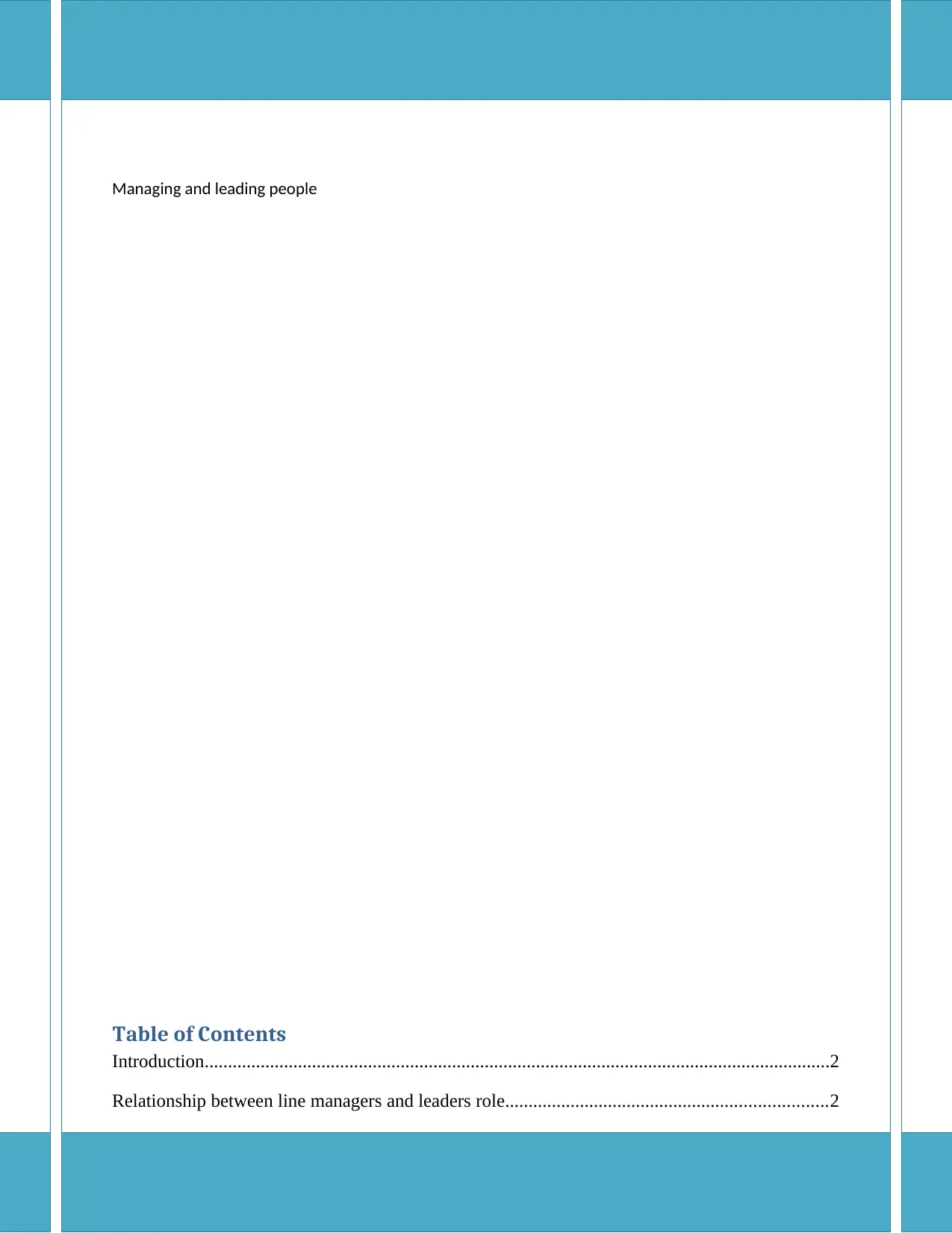
Managing and leading people
Table of Contents
Introduction......................................................................................................................................2
Relationship between line managers and leaders role.....................................................................2
Table of Contents
Introduction......................................................................................................................................2
Relationship between line managers and leaders role.....................................................................2
Paraphrase This Document
Need a fresh take? Get an instant paraphrase of this document with our AI Paraphraser
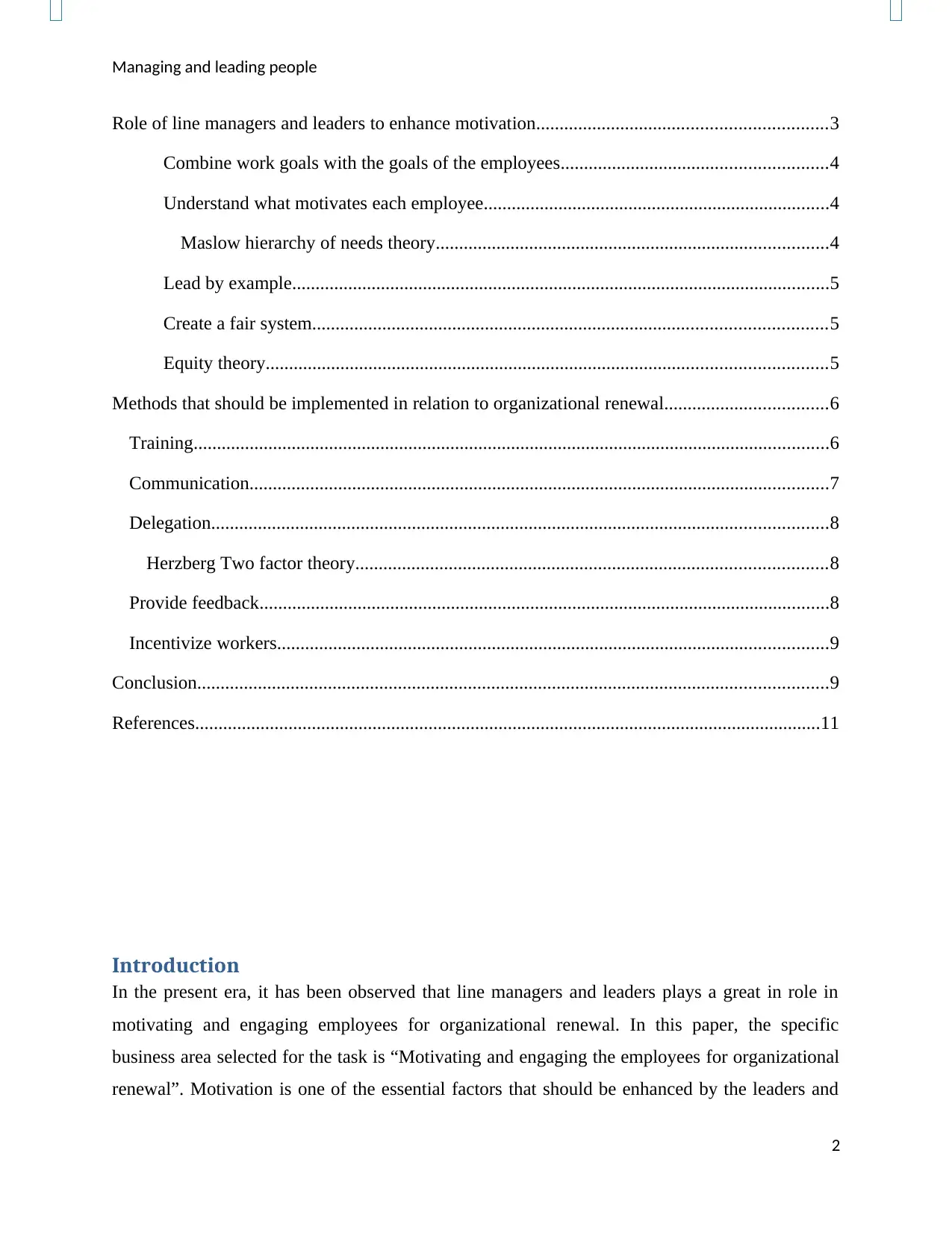
Managing and leading people
Role of line managers and leaders to enhance motivation..............................................................3
Combine work goals with the goals of the employees.........................................................4
Understand what motivates each employee..........................................................................4
Maslow hierarchy of needs theory....................................................................................4
Lead by example...................................................................................................................5
Create a fair system..............................................................................................................5
Equity theory........................................................................................................................5
Methods that should be implemented in relation to organizational renewal...................................6
Training........................................................................................................................................6
Communication............................................................................................................................7
Delegation....................................................................................................................................8
Herzberg Two factor theory.....................................................................................................8
Provide feedback..........................................................................................................................8
Incentivize workers......................................................................................................................9
Conclusion.......................................................................................................................................9
References......................................................................................................................................11
Introduction
In the present era, it has been observed that line managers and leaders plays a great in role in
motivating and engaging employees for organizational renewal. In this paper, the specific
business area selected for the task is “Motivating and engaging the employees for organizational
renewal”. Motivation is one of the essential factors that should be enhanced by the leaders and
2
Role of line managers and leaders to enhance motivation..............................................................3
Combine work goals with the goals of the employees.........................................................4
Understand what motivates each employee..........................................................................4
Maslow hierarchy of needs theory....................................................................................4
Lead by example...................................................................................................................5
Create a fair system..............................................................................................................5
Equity theory........................................................................................................................5
Methods that should be implemented in relation to organizational renewal...................................6
Training........................................................................................................................................6
Communication............................................................................................................................7
Delegation....................................................................................................................................8
Herzberg Two factor theory.....................................................................................................8
Provide feedback..........................................................................................................................8
Incentivize workers......................................................................................................................9
Conclusion.......................................................................................................................................9
References......................................................................................................................................11
Introduction
In the present era, it has been observed that line managers and leaders plays a great in role in
motivating and engaging employees for organizational renewal. In this paper, the specific
business area selected for the task is “Motivating and engaging the employees for organizational
renewal”. Motivation is one of the essential factors that should be enhanced by the leaders and
2
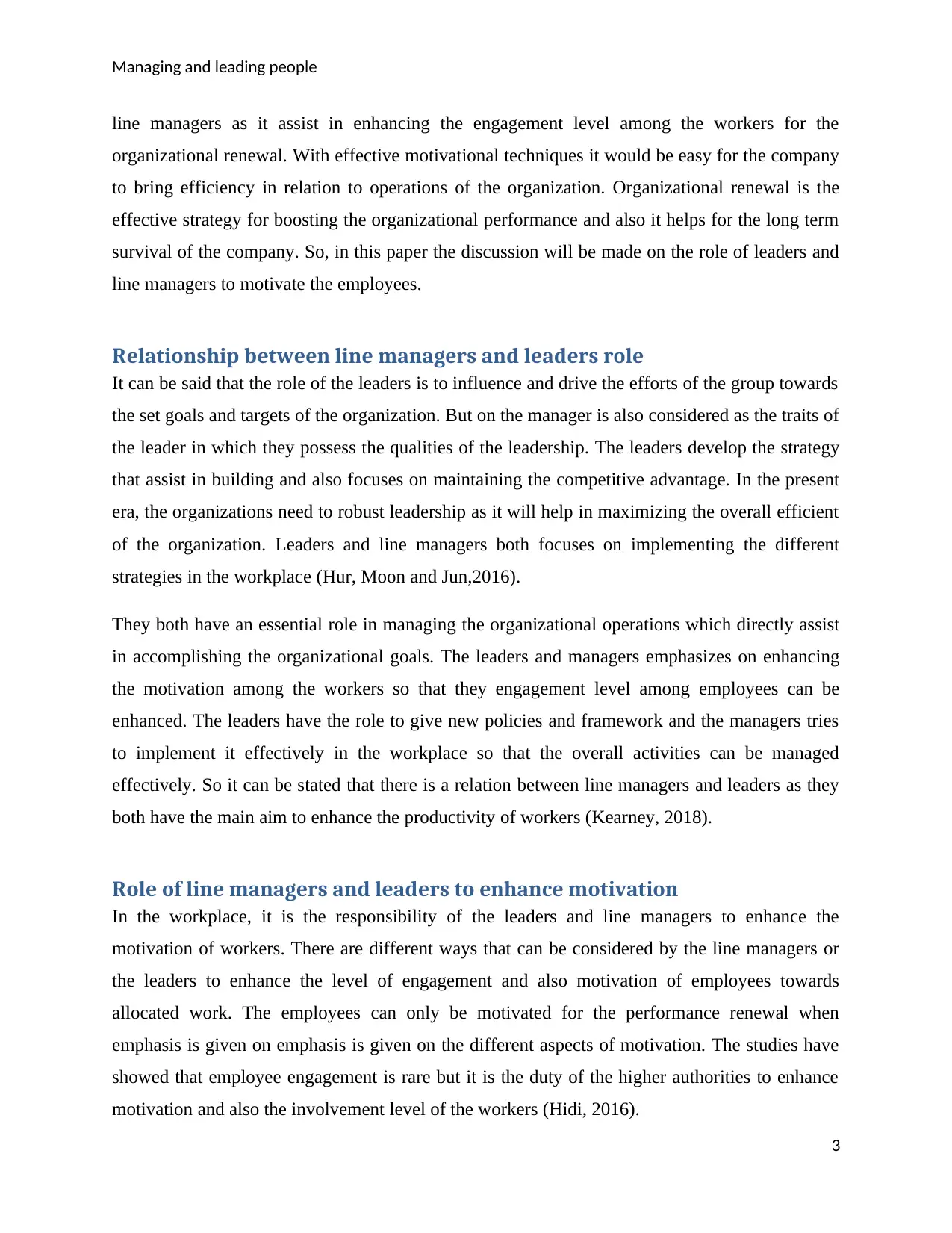
Managing and leading people
line managers as it assist in enhancing the engagement level among the workers for the
organizational renewal. With effective motivational techniques it would be easy for the company
to bring efficiency in relation to operations of the organization. Organizational renewal is the
effective strategy for boosting the organizational performance and also it helps for the long term
survival of the company. So, in this paper the discussion will be made on the role of leaders and
line managers to motivate the employees.
Relationship between line managers and leaders role
It can be said that the role of the leaders is to influence and drive the efforts of the group towards
the set goals and targets of the organization. But on the manager is also considered as the traits of
the leader in which they possess the qualities of the leadership. The leaders develop the strategy
that assist in building and also focuses on maintaining the competitive advantage. In the present
era, the organizations need to robust leadership as it will help in maximizing the overall efficient
of the organization. Leaders and line managers both focuses on implementing the different
strategies in the workplace (Hur, Moon and Jun,2016).
They both have an essential role in managing the organizational operations which directly assist
in accomplishing the organizational goals. The leaders and managers emphasizes on enhancing
the motivation among the workers so that they engagement level among employees can be
enhanced. The leaders have the role to give new policies and framework and the managers tries
to implement it effectively in the workplace so that the overall activities can be managed
effectively. So it can be stated that there is a relation between line managers and leaders as they
both have the main aim to enhance the productivity of workers (Kearney, 2018).
Role of line managers and leaders to enhance motivation
In the workplace, it is the responsibility of the leaders and line managers to enhance the
motivation of workers. There are different ways that can be considered by the line managers or
the leaders to enhance the level of engagement and also motivation of employees towards
allocated work. The employees can only be motivated for the performance renewal when
emphasis is given on emphasis is given on the different aspects of motivation. The studies have
showed that employee engagement is rare but it is the duty of the higher authorities to enhance
motivation and also the involvement level of the workers (Hidi, 2016).
3
line managers as it assist in enhancing the engagement level among the workers for the
organizational renewal. With effective motivational techniques it would be easy for the company
to bring efficiency in relation to operations of the organization. Organizational renewal is the
effective strategy for boosting the organizational performance and also it helps for the long term
survival of the company. So, in this paper the discussion will be made on the role of leaders and
line managers to motivate the employees.
Relationship between line managers and leaders role
It can be said that the role of the leaders is to influence and drive the efforts of the group towards
the set goals and targets of the organization. But on the manager is also considered as the traits of
the leader in which they possess the qualities of the leadership. The leaders develop the strategy
that assist in building and also focuses on maintaining the competitive advantage. In the present
era, the organizations need to robust leadership as it will help in maximizing the overall efficient
of the organization. Leaders and line managers both focuses on implementing the different
strategies in the workplace (Hur, Moon and Jun,2016).
They both have an essential role in managing the organizational operations which directly assist
in accomplishing the organizational goals. The leaders and managers emphasizes on enhancing
the motivation among the workers so that they engagement level among employees can be
enhanced. The leaders have the role to give new policies and framework and the managers tries
to implement it effectively in the workplace so that the overall activities can be managed
effectively. So it can be stated that there is a relation between line managers and leaders as they
both have the main aim to enhance the productivity of workers (Kearney, 2018).
Role of line managers and leaders to enhance motivation
In the workplace, it is the responsibility of the leaders and line managers to enhance the
motivation of workers. There are different ways that can be considered by the line managers or
the leaders to enhance the level of engagement and also motivation of employees towards
allocated work. The employees can only be motivated for the performance renewal when
emphasis is given on emphasis is given on the different aspects of motivation. The studies have
showed that employee engagement is rare but it is the duty of the higher authorities to enhance
motivation and also the involvement level of the workers (Hidi, 2016).
3
⊘ This is a preview!⊘
Do you want full access?
Subscribe today to unlock all pages.

Trusted by 1+ million students worldwide
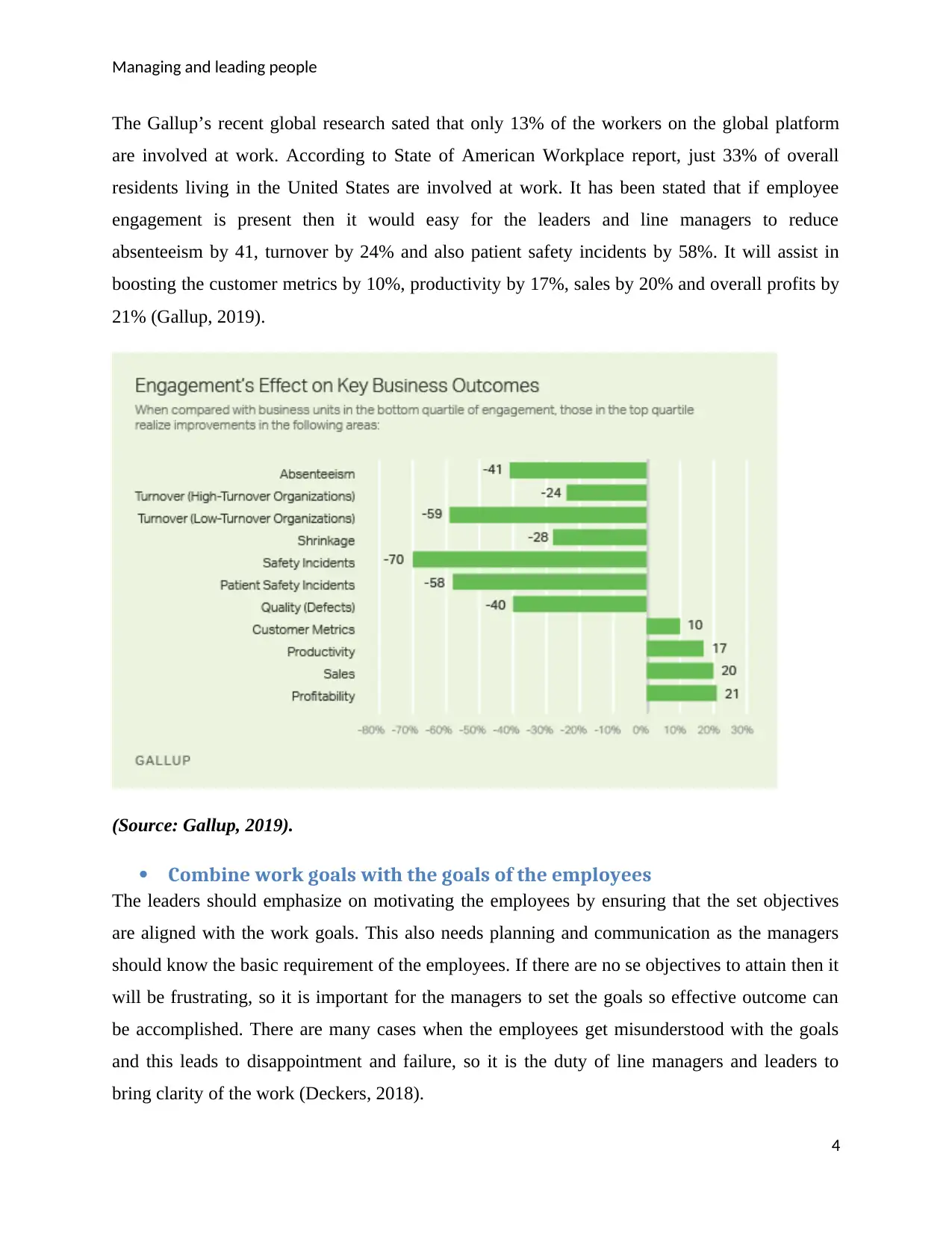
Managing and leading people
The Gallup’s recent global research sated that only 13% of the workers on the global platform
are involved at work. According to State of American Workplace report, just 33% of overall
residents living in the United States are involved at work. It has been stated that if employee
engagement is present then it would easy for the leaders and line managers to reduce
absenteeism by 41, turnover by 24% and also patient safety incidents by 58%. It will assist in
boosting the customer metrics by 10%, productivity by 17%, sales by 20% and overall profits by
21% (Gallup, 2019).
(Source: Gallup, 2019).
Combine work goals with the goals of the employees
The leaders should emphasize on motivating the employees by ensuring that the set objectives
are aligned with the work goals. This also needs planning and communication as the managers
should know the basic requirement of the employees. If there are no se objectives to attain then it
will be frustrating, so it is important for the managers to set the goals so effective outcome can
be accomplished. There are many cases when the employees get misunderstood with the goals
and this leads to disappointment and failure, so it is the duty of line managers and leaders to
bring clarity of the work (Deckers, 2018).
4
The Gallup’s recent global research sated that only 13% of the workers on the global platform
are involved at work. According to State of American Workplace report, just 33% of overall
residents living in the United States are involved at work. It has been stated that if employee
engagement is present then it would easy for the leaders and line managers to reduce
absenteeism by 41, turnover by 24% and also patient safety incidents by 58%. It will assist in
boosting the customer metrics by 10%, productivity by 17%, sales by 20% and overall profits by
21% (Gallup, 2019).
(Source: Gallup, 2019).
Combine work goals with the goals of the employees
The leaders should emphasize on motivating the employees by ensuring that the set objectives
are aligned with the work goals. This also needs planning and communication as the managers
should know the basic requirement of the employees. If there are no se objectives to attain then it
will be frustrating, so it is important for the managers to set the goals so effective outcome can
be accomplished. There are many cases when the employees get misunderstood with the goals
and this leads to disappointment and failure, so it is the duty of line managers and leaders to
bring clarity of the work (Deckers, 2018).
4
Paraphrase This Document
Need a fresh take? Get an instant paraphrase of this document with our AI Paraphraser
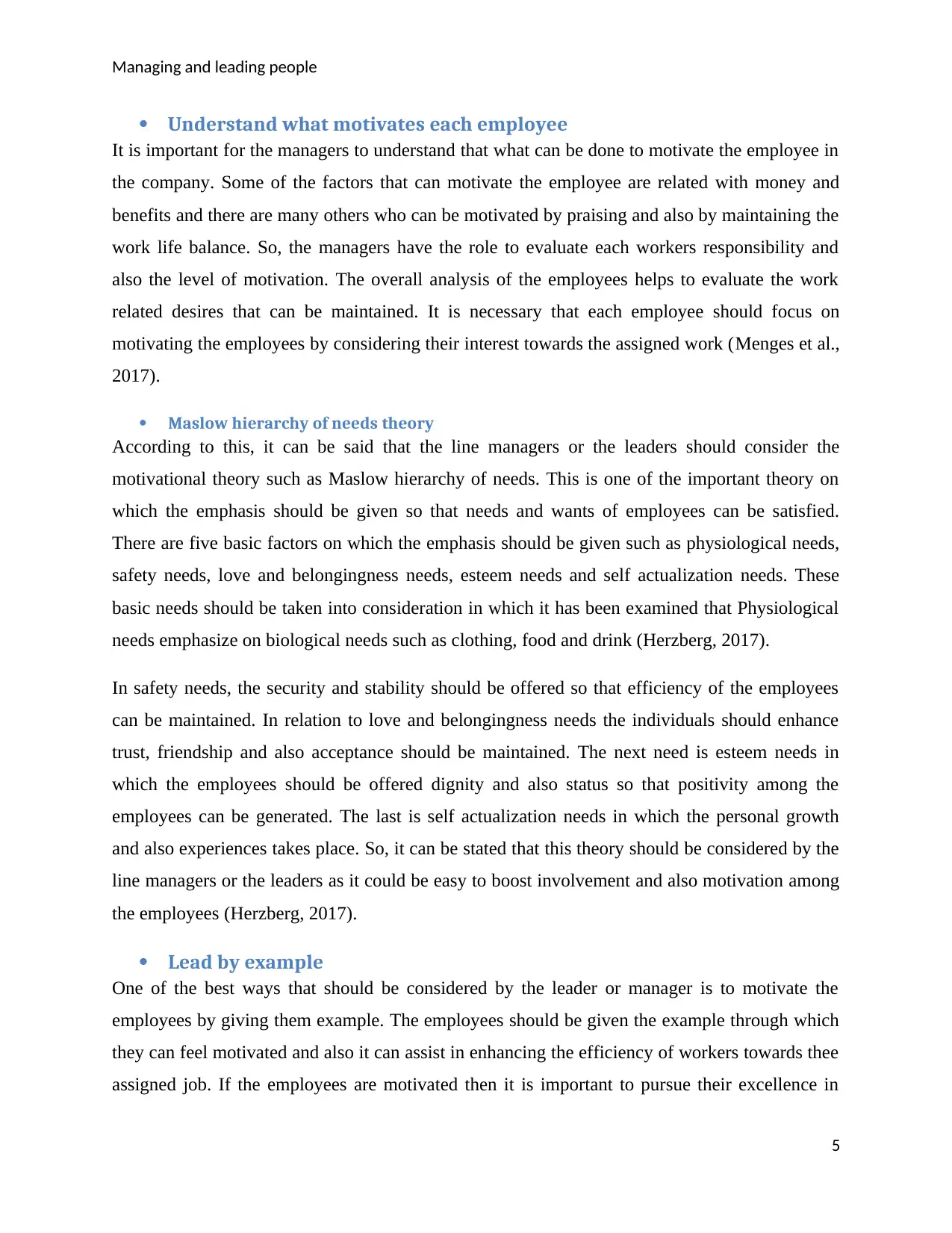
Managing and leading people
Understand what motivates each employee
It is important for the managers to understand that what can be done to motivate the employee in
the company. Some of the factors that can motivate the employee are related with money and
benefits and there are many others who can be motivated by praising and also by maintaining the
work life balance. So, the managers have the role to evaluate each workers responsibility and
also the level of motivation. The overall analysis of the employees helps to evaluate the work
related desires that can be maintained. It is necessary that each employee should focus on
motivating the employees by considering their interest towards the assigned work (Menges et al.,
2017).
Maslow hierarchy of needs theory
According to this, it can be said that the line managers or the leaders should consider the
motivational theory such as Maslow hierarchy of needs. This is one of the important theory on
which the emphasis should be given so that needs and wants of employees can be satisfied.
There are five basic factors on which the emphasis should be given such as physiological needs,
safety needs, love and belongingness needs, esteem needs and self actualization needs. These
basic needs should be taken into consideration in which it has been examined that Physiological
needs emphasize on biological needs such as clothing, food and drink (Herzberg, 2017).
In safety needs, the security and stability should be offered so that efficiency of the employees
can be maintained. In relation to love and belongingness needs the individuals should enhance
trust, friendship and also acceptance should be maintained. The next need is esteem needs in
which the employees should be offered dignity and also status so that positivity among the
employees can be generated. The last is self actualization needs in which the personal growth
and also experiences takes place. So, it can be stated that this theory should be considered by the
line managers or the leaders as it could be easy to boost involvement and also motivation among
the employees (Herzberg, 2017).
Lead by example
One of the best ways that should be considered by the leader or manager is to motivate the
employees by giving them example. The employees should be given the example through which
they can feel motivated and also it can assist in enhancing the efficiency of workers towards thee
assigned job. If the employees are motivated then it is important to pursue their excellence in
5
Understand what motivates each employee
It is important for the managers to understand that what can be done to motivate the employee in
the company. Some of the factors that can motivate the employee are related with money and
benefits and there are many others who can be motivated by praising and also by maintaining the
work life balance. So, the managers have the role to evaluate each workers responsibility and
also the level of motivation. The overall analysis of the employees helps to evaluate the work
related desires that can be maintained. It is necessary that each employee should focus on
motivating the employees by considering their interest towards the assigned work (Menges et al.,
2017).
Maslow hierarchy of needs theory
According to this, it can be said that the line managers or the leaders should consider the
motivational theory such as Maslow hierarchy of needs. This is one of the important theory on
which the emphasis should be given so that needs and wants of employees can be satisfied.
There are five basic factors on which the emphasis should be given such as physiological needs,
safety needs, love and belongingness needs, esteem needs and self actualization needs. These
basic needs should be taken into consideration in which it has been examined that Physiological
needs emphasize on biological needs such as clothing, food and drink (Herzberg, 2017).
In safety needs, the security and stability should be offered so that efficiency of the employees
can be maintained. In relation to love and belongingness needs the individuals should enhance
trust, friendship and also acceptance should be maintained. The next need is esteem needs in
which the employees should be offered dignity and also status so that positivity among the
employees can be generated. The last is self actualization needs in which the personal growth
and also experiences takes place. So, it can be stated that this theory should be considered by the
line managers or the leaders as it could be easy to boost involvement and also motivation among
the employees (Herzberg, 2017).
Lead by example
One of the best ways that should be considered by the leader or manager is to motivate the
employees by giving them example. The employees should be given the example through which
they can feel motivated and also it can assist in enhancing the efficiency of workers towards thee
assigned job. If the employees are motivated then it is important to pursue their excellence in
5
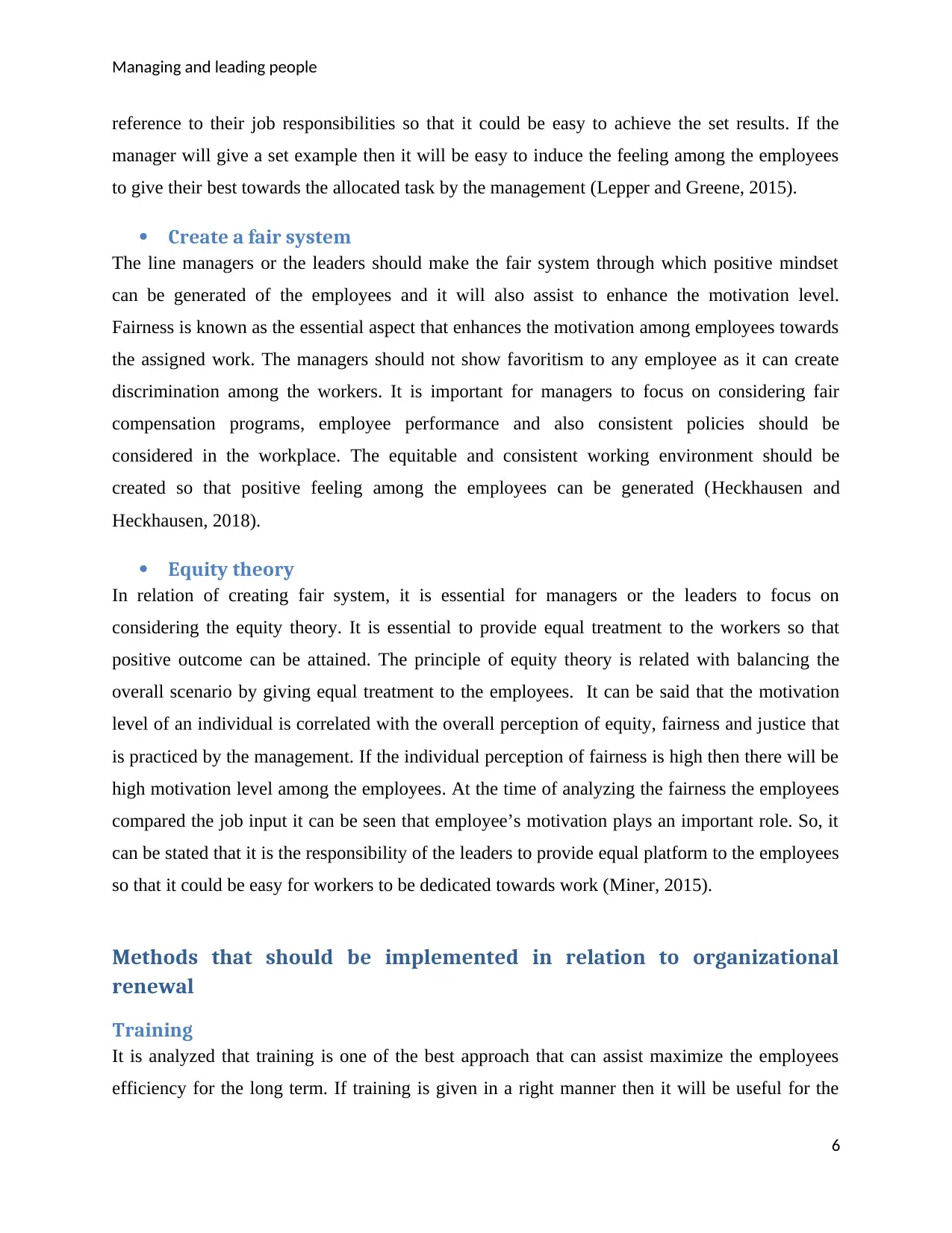
Managing and leading people
reference to their job responsibilities so that it could be easy to achieve the set results. If the
manager will give a set example then it will be easy to induce the feeling among the employees
to give their best towards the allocated task by the management (Lepper and Greene, 2015).
Create a fair system
The line managers or the leaders should make the fair system through which positive mindset
can be generated of the employees and it will also assist to enhance the motivation level.
Fairness is known as the essential aspect that enhances the motivation among employees towards
the assigned work. The managers should not show favoritism to any employee as it can create
discrimination among the workers. It is important for managers to focus on considering fair
compensation programs, employee performance and also consistent policies should be
considered in the workplace. The equitable and consistent working environment should be
created so that positive feeling among the employees can be generated (Heckhausen and
Heckhausen, 2018).
Equity theory
In relation of creating fair system, it is essential for managers or the leaders to focus on
considering the equity theory. It is essential to provide equal treatment to the workers so that
positive outcome can be attained. The principle of equity theory is related with balancing the
overall scenario by giving equal treatment to the employees. It can be said that the motivation
level of an individual is correlated with the overall perception of equity, fairness and justice that
is practiced by the management. If the individual perception of fairness is high then there will be
high motivation level among the employees. At the time of analyzing the fairness the employees
compared the job input it can be seen that employee’s motivation plays an important role. So, it
can be stated that it is the responsibility of the leaders to provide equal platform to the employees
so that it could be easy for workers to be dedicated towards work (Miner, 2015).
Methods that should be implemented in relation to organizational
renewal
Training
It is analyzed that training is one of the best approach that can assist maximize the employees
efficiency for the long term. If training is given in a right manner then it will be useful for the
6
reference to their job responsibilities so that it could be easy to achieve the set results. If the
manager will give a set example then it will be easy to induce the feeling among the employees
to give their best towards the allocated task by the management (Lepper and Greene, 2015).
Create a fair system
The line managers or the leaders should make the fair system through which positive mindset
can be generated of the employees and it will also assist to enhance the motivation level.
Fairness is known as the essential aspect that enhances the motivation among employees towards
the assigned work. The managers should not show favoritism to any employee as it can create
discrimination among the workers. It is important for managers to focus on considering fair
compensation programs, employee performance and also consistent policies should be
considered in the workplace. The equitable and consistent working environment should be
created so that positive feeling among the employees can be generated (Heckhausen and
Heckhausen, 2018).
Equity theory
In relation of creating fair system, it is essential for managers or the leaders to focus on
considering the equity theory. It is essential to provide equal treatment to the workers so that
positive outcome can be attained. The principle of equity theory is related with balancing the
overall scenario by giving equal treatment to the employees. It can be said that the motivation
level of an individual is correlated with the overall perception of equity, fairness and justice that
is practiced by the management. If the individual perception of fairness is high then there will be
high motivation level among the employees. At the time of analyzing the fairness the employees
compared the job input it can be seen that employee’s motivation plays an important role. So, it
can be stated that it is the responsibility of the leaders to provide equal platform to the employees
so that it could be easy for workers to be dedicated towards work (Miner, 2015).
Methods that should be implemented in relation to organizational
renewal
Training
It is analyzed that training is one of the best approach that can assist maximize the employees
efficiency for the long term. If training is given in a right manner then it will be useful for the
6
⊘ This is a preview!⊘
Do you want full access?
Subscribe today to unlock all pages.

Trusted by 1+ million students worldwide
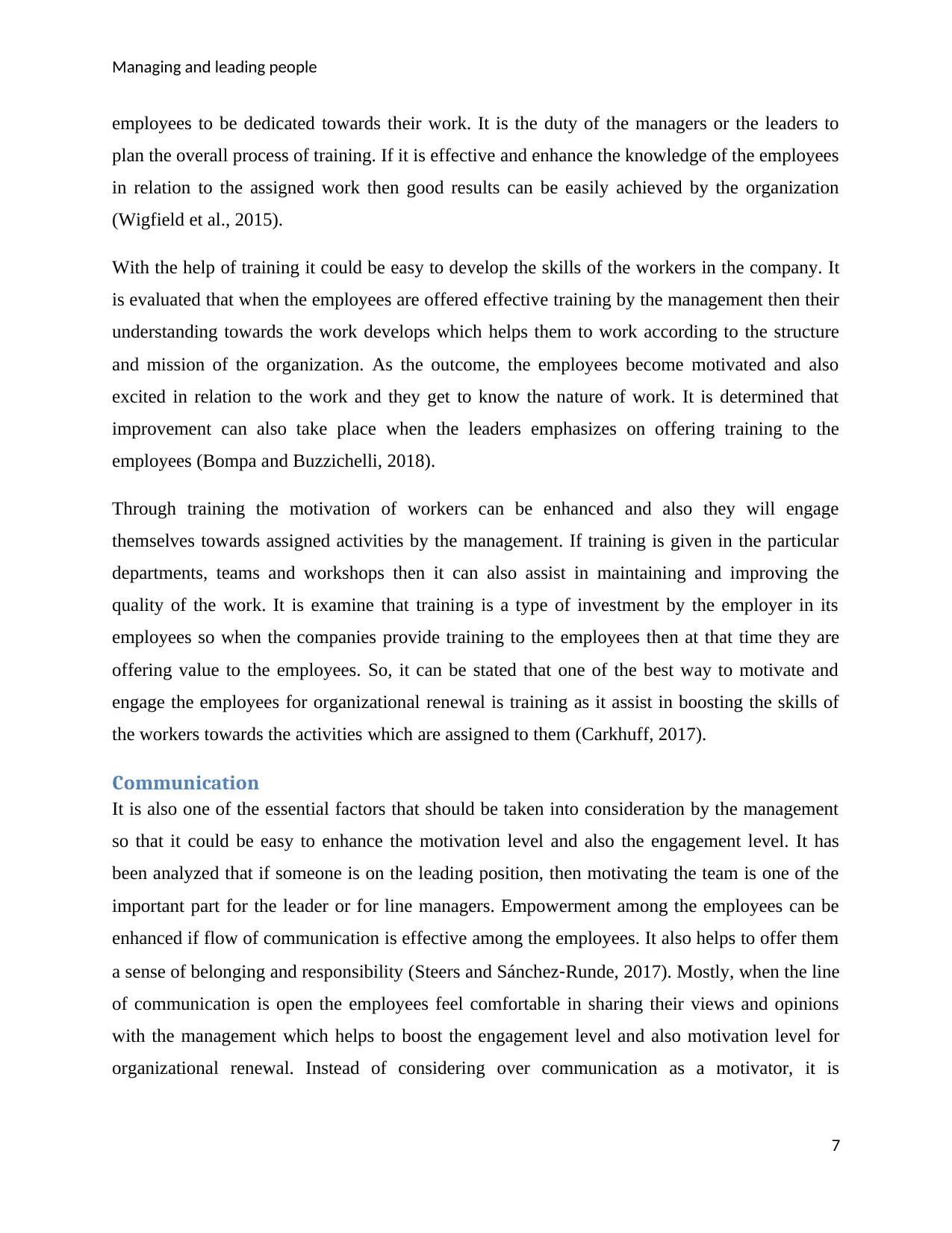
Managing and leading people
employees to be dedicated towards their work. It is the duty of the managers or the leaders to
plan the overall process of training. If it is effective and enhance the knowledge of the employees
in relation to the assigned work then good results can be easily achieved by the organization
(Wigfield et al., 2015).
With the help of training it could be easy to develop the skills of the workers in the company. It
is evaluated that when the employees are offered effective training by the management then their
understanding towards the work develops which helps them to work according to the structure
and mission of the organization. As the outcome, the employees become motivated and also
excited in relation to the work and they get to know the nature of work. It is determined that
improvement can also take place when the leaders emphasizes on offering training to the
employees (Bompa and Buzzichelli, 2018).
Through training the motivation of workers can be enhanced and also they will engage
themselves towards assigned activities by the management. If training is given in the particular
departments, teams and workshops then it can also assist in maintaining and improving the
quality of the work. It is examine that training is a type of investment by the employer in its
employees so when the companies provide training to the employees then at that time they are
offering value to the employees. So, it can be stated that one of the best way to motivate and
engage the employees for organizational renewal is training as it assist in boosting the skills of
the workers towards the activities which are assigned to them (Carkhuff, 2017).
Communication
It is also one of the essential factors that should be taken into consideration by the management
so that it could be easy to enhance the motivation level and also the engagement level. It has
been analyzed that if someone is on the leading position, then motivating the team is one of the
important part for the leader or for line managers. Empowerment among the employees can be
enhanced if flow of communication is effective among the employees. It also helps to offer them
a sense of belonging and responsibility (Steers and Sánchez‐Runde, 2017). Mostly, when the line
of communication is open the employees feel comfortable in sharing their views and opinions
with the management which helps to boost the engagement level and also motivation level for
organizational renewal. Instead of considering over communication as a motivator, it is
7
employees to be dedicated towards their work. It is the duty of the managers or the leaders to
plan the overall process of training. If it is effective and enhance the knowledge of the employees
in relation to the assigned work then good results can be easily achieved by the organization
(Wigfield et al., 2015).
With the help of training it could be easy to develop the skills of the workers in the company. It
is evaluated that when the employees are offered effective training by the management then their
understanding towards the work develops which helps them to work according to the structure
and mission of the organization. As the outcome, the employees become motivated and also
excited in relation to the work and they get to know the nature of work. It is determined that
improvement can also take place when the leaders emphasizes on offering training to the
employees (Bompa and Buzzichelli, 2018).
Through training the motivation of workers can be enhanced and also they will engage
themselves towards assigned activities by the management. If training is given in the particular
departments, teams and workshops then it can also assist in maintaining and improving the
quality of the work. It is examine that training is a type of investment by the employer in its
employees so when the companies provide training to the employees then at that time they are
offering value to the employees. So, it can be stated that one of the best way to motivate and
engage the employees for organizational renewal is training as it assist in boosting the skills of
the workers towards the activities which are assigned to them (Carkhuff, 2017).
Communication
It is also one of the essential factors that should be taken into consideration by the management
so that it could be easy to enhance the motivation level and also the engagement level. It has
been analyzed that if someone is on the leading position, then motivating the team is one of the
important part for the leader or for line managers. Empowerment among the employees can be
enhanced if flow of communication is effective among the employees. It also helps to offer them
a sense of belonging and responsibility (Steers and Sánchez‐Runde, 2017). Mostly, when the line
of communication is open the employees feel comfortable in sharing their views and opinions
with the management which helps to boost the engagement level and also motivation level for
organizational renewal. Instead of considering over communication as a motivator, it is
7
Paraphrase This Document
Need a fresh take? Get an instant paraphrase of this document with our AI Paraphraser
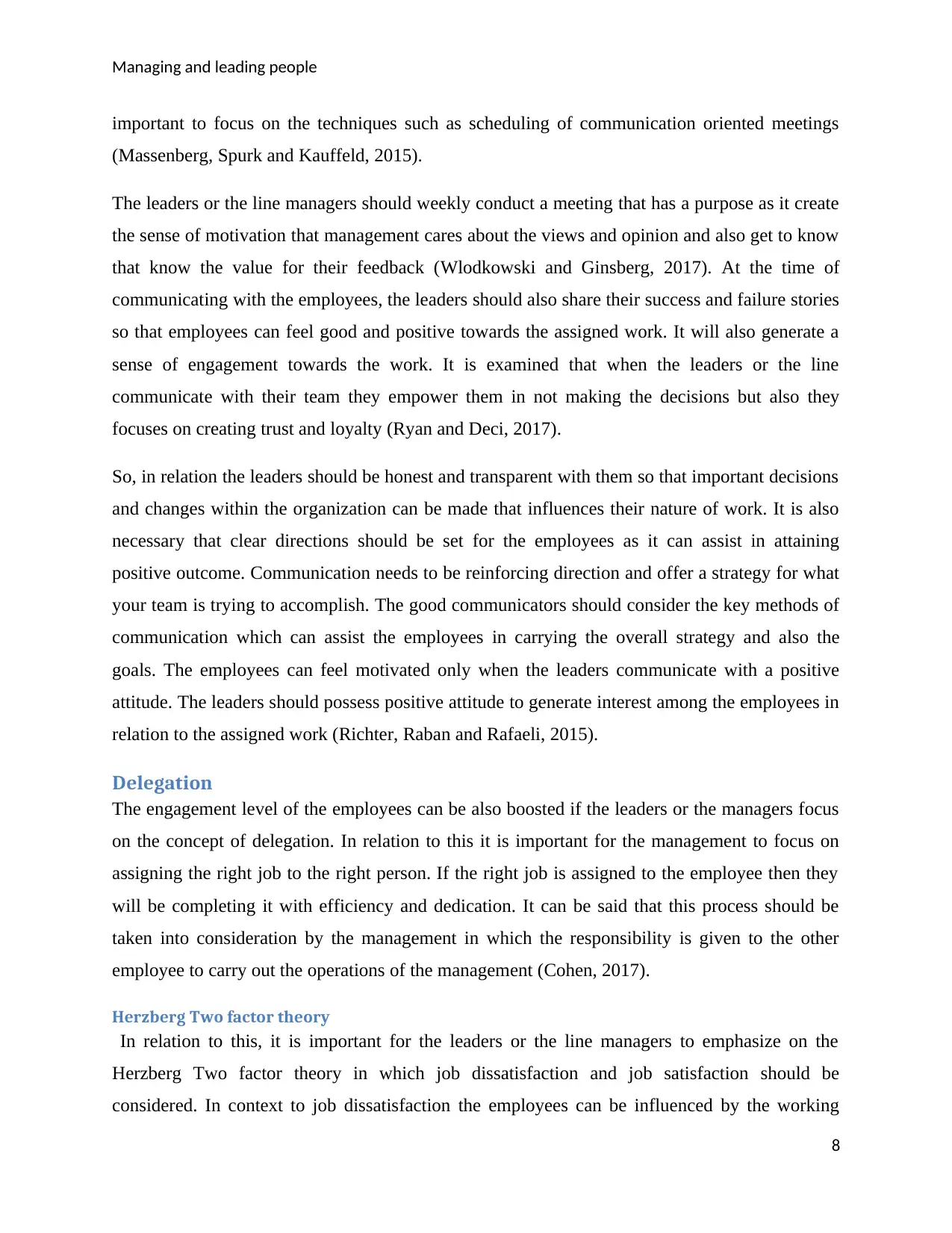
Managing and leading people
important to focus on the techniques such as scheduling of communication oriented meetings
(Massenberg, Spurk and Kauffeld, 2015).
The leaders or the line managers should weekly conduct a meeting that has a purpose as it create
the sense of motivation that management cares about the views and opinion and also get to know
that know the value for their feedback (Wlodkowski and Ginsberg, 2017). At the time of
communicating with the employees, the leaders should also share their success and failure stories
so that employees can feel good and positive towards the assigned work. It will also generate a
sense of engagement towards the work. It is examined that when the leaders or the line
communicate with their team they empower them in not making the decisions but also they
focuses on creating trust and loyalty (Ryan and Deci, 2017).
So, in relation the leaders should be honest and transparent with them so that important decisions
and changes within the organization can be made that influences their nature of work. It is also
necessary that clear directions should be set for the employees as it can assist in attaining
positive outcome. Communication needs to be reinforcing direction and offer a strategy for what
your team is trying to accomplish. The good communicators should consider the key methods of
communication which can assist the employees in carrying the overall strategy and also the
goals. The employees can feel motivated only when the leaders communicate with a positive
attitude. The leaders should possess positive attitude to generate interest among the employees in
relation to the assigned work (Richter, Raban and Rafaeli, 2015).
Delegation
The engagement level of the employees can be also boosted if the leaders or the managers focus
on the concept of delegation. In relation to this it is important for the management to focus on
assigning the right job to the right person. If the right job is assigned to the employee then they
will be completing it with efficiency and dedication. It can be said that this process should be
taken into consideration by the management in which the responsibility is given to the other
employee to carry out the operations of the management (Cohen, 2017).
Herzberg Two factor theory
In relation to this, it is important for the leaders or the line managers to emphasize on the
Herzberg Two factor theory in which job dissatisfaction and job satisfaction should be
considered. In context to job dissatisfaction the employees can be influenced by the working
8
important to focus on the techniques such as scheduling of communication oriented meetings
(Massenberg, Spurk and Kauffeld, 2015).
The leaders or the line managers should weekly conduct a meeting that has a purpose as it create
the sense of motivation that management cares about the views and opinion and also get to know
that know the value for their feedback (Wlodkowski and Ginsberg, 2017). At the time of
communicating with the employees, the leaders should also share their success and failure stories
so that employees can feel good and positive towards the assigned work. It will also generate a
sense of engagement towards the work. It is examined that when the leaders or the line
communicate with their team they empower them in not making the decisions but also they
focuses on creating trust and loyalty (Ryan and Deci, 2017).
So, in relation the leaders should be honest and transparent with them so that important decisions
and changes within the organization can be made that influences their nature of work. It is also
necessary that clear directions should be set for the employees as it can assist in attaining
positive outcome. Communication needs to be reinforcing direction and offer a strategy for what
your team is trying to accomplish. The good communicators should consider the key methods of
communication which can assist the employees in carrying the overall strategy and also the
goals. The employees can feel motivated only when the leaders communicate with a positive
attitude. The leaders should possess positive attitude to generate interest among the employees in
relation to the assigned work (Richter, Raban and Rafaeli, 2015).
Delegation
The engagement level of the employees can be also boosted if the leaders or the managers focus
on the concept of delegation. In relation to this it is important for the management to focus on
assigning the right job to the right person. If the right job is assigned to the employee then they
will be completing it with efficiency and dedication. It can be said that this process should be
taken into consideration by the management in which the responsibility is given to the other
employee to carry out the operations of the management (Cohen, 2017).
Herzberg Two factor theory
In relation to this, it is important for the leaders or the line managers to emphasize on the
Herzberg Two factor theory in which job dissatisfaction and job satisfaction should be
considered. In context to job dissatisfaction the employees can be influenced by the working
8
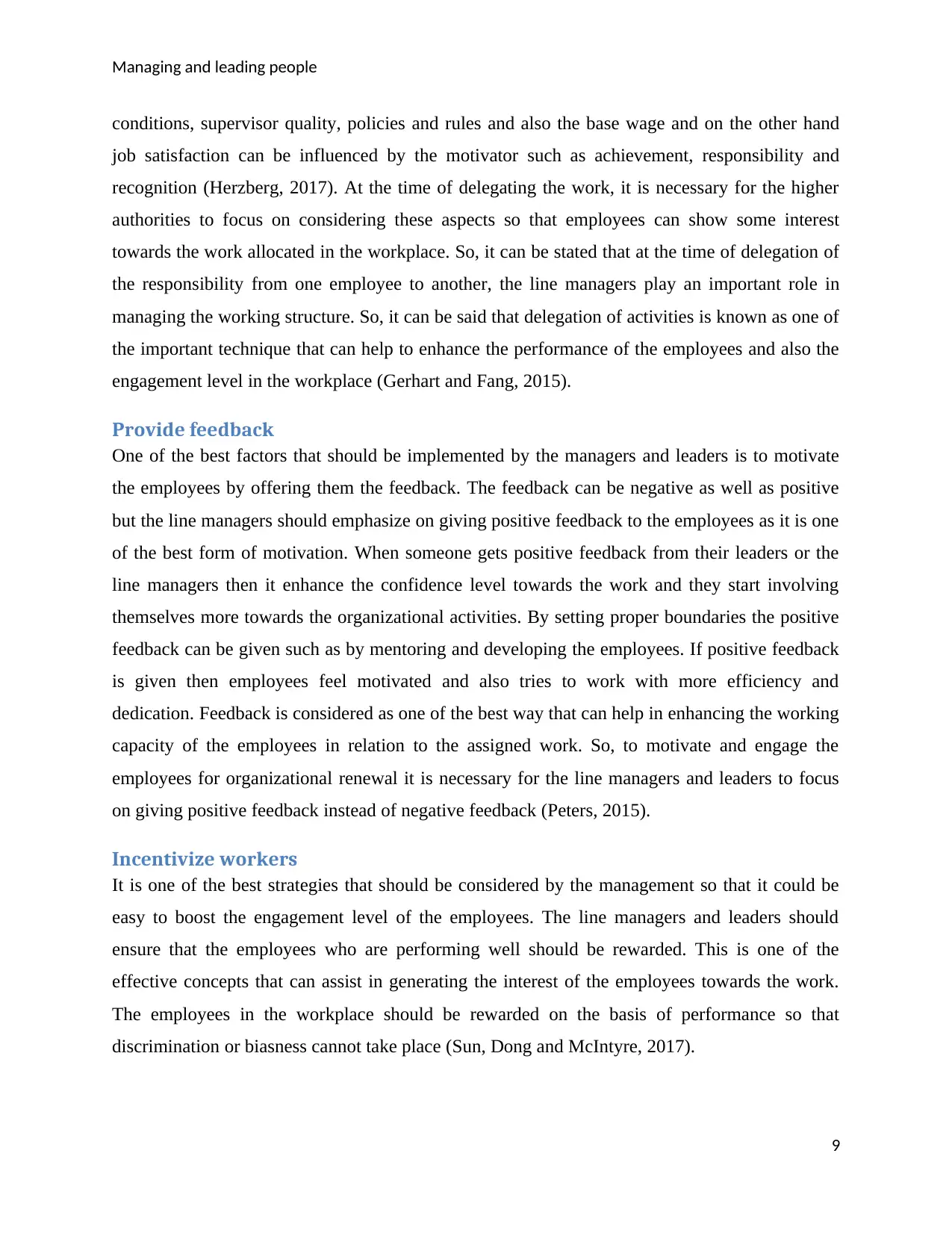
Managing and leading people
conditions, supervisor quality, policies and rules and also the base wage and on the other hand
job satisfaction can be influenced by the motivator such as achievement, responsibility and
recognition (Herzberg, 2017). At the time of delegating the work, it is necessary for the higher
authorities to focus on considering these aspects so that employees can show some interest
towards the work allocated in the workplace. So, it can be stated that at the time of delegation of
the responsibility from one employee to another, the line managers play an important role in
managing the working structure. So, it can be said that delegation of activities is known as one of
the important technique that can help to enhance the performance of the employees and also the
engagement level in the workplace (Gerhart and Fang, 2015).
Provide feedback
One of the best factors that should be implemented by the managers and leaders is to motivate
the employees by offering them the feedback. The feedback can be negative as well as positive
but the line managers should emphasize on giving positive feedback to the employees as it is one
of the best form of motivation. When someone gets positive feedback from their leaders or the
line managers then it enhance the confidence level towards the work and they start involving
themselves more towards the organizational activities. By setting proper boundaries the positive
feedback can be given such as by mentoring and developing the employees. If positive feedback
is given then employees feel motivated and also tries to work with more efficiency and
dedication. Feedback is considered as one of the best way that can help in enhancing the working
capacity of the employees in relation to the assigned work. So, to motivate and engage the
employees for organizational renewal it is necessary for the line managers and leaders to focus
on giving positive feedback instead of negative feedback (Peters, 2015).
Incentivize workers
It is one of the best strategies that should be considered by the management so that it could be
easy to boost the engagement level of the employees. The line managers and leaders should
ensure that the employees who are performing well should be rewarded. This is one of the
effective concepts that can assist in generating the interest of the employees towards the work.
The employees in the workplace should be rewarded on the basis of performance so that
discrimination or biasness cannot take place (Sun, Dong and McIntyre, 2017).
9
conditions, supervisor quality, policies and rules and also the base wage and on the other hand
job satisfaction can be influenced by the motivator such as achievement, responsibility and
recognition (Herzberg, 2017). At the time of delegating the work, it is necessary for the higher
authorities to focus on considering these aspects so that employees can show some interest
towards the work allocated in the workplace. So, it can be stated that at the time of delegation of
the responsibility from one employee to another, the line managers play an important role in
managing the working structure. So, it can be said that delegation of activities is known as one of
the important technique that can help to enhance the performance of the employees and also the
engagement level in the workplace (Gerhart and Fang, 2015).
Provide feedback
One of the best factors that should be implemented by the managers and leaders is to motivate
the employees by offering them the feedback. The feedback can be negative as well as positive
but the line managers should emphasize on giving positive feedback to the employees as it is one
of the best form of motivation. When someone gets positive feedback from their leaders or the
line managers then it enhance the confidence level towards the work and they start involving
themselves more towards the organizational activities. By setting proper boundaries the positive
feedback can be given such as by mentoring and developing the employees. If positive feedback
is given then employees feel motivated and also tries to work with more efficiency and
dedication. Feedback is considered as one of the best way that can help in enhancing the working
capacity of the employees in relation to the assigned work. So, to motivate and engage the
employees for organizational renewal it is necessary for the line managers and leaders to focus
on giving positive feedback instead of negative feedback (Peters, 2015).
Incentivize workers
It is one of the best strategies that should be considered by the management so that it could be
easy to boost the engagement level of the employees. The line managers and leaders should
ensure that the employees who are performing well should be rewarded. This is one of the
effective concepts that can assist in generating the interest of the employees towards the work.
The employees in the workplace should be rewarded on the basis of performance so that
discrimination or biasness cannot take place (Sun, Dong and McIntyre, 2017).
9
⊘ This is a preview!⊘
Do you want full access?
Subscribe today to unlock all pages.

Trusted by 1+ million students worldwide
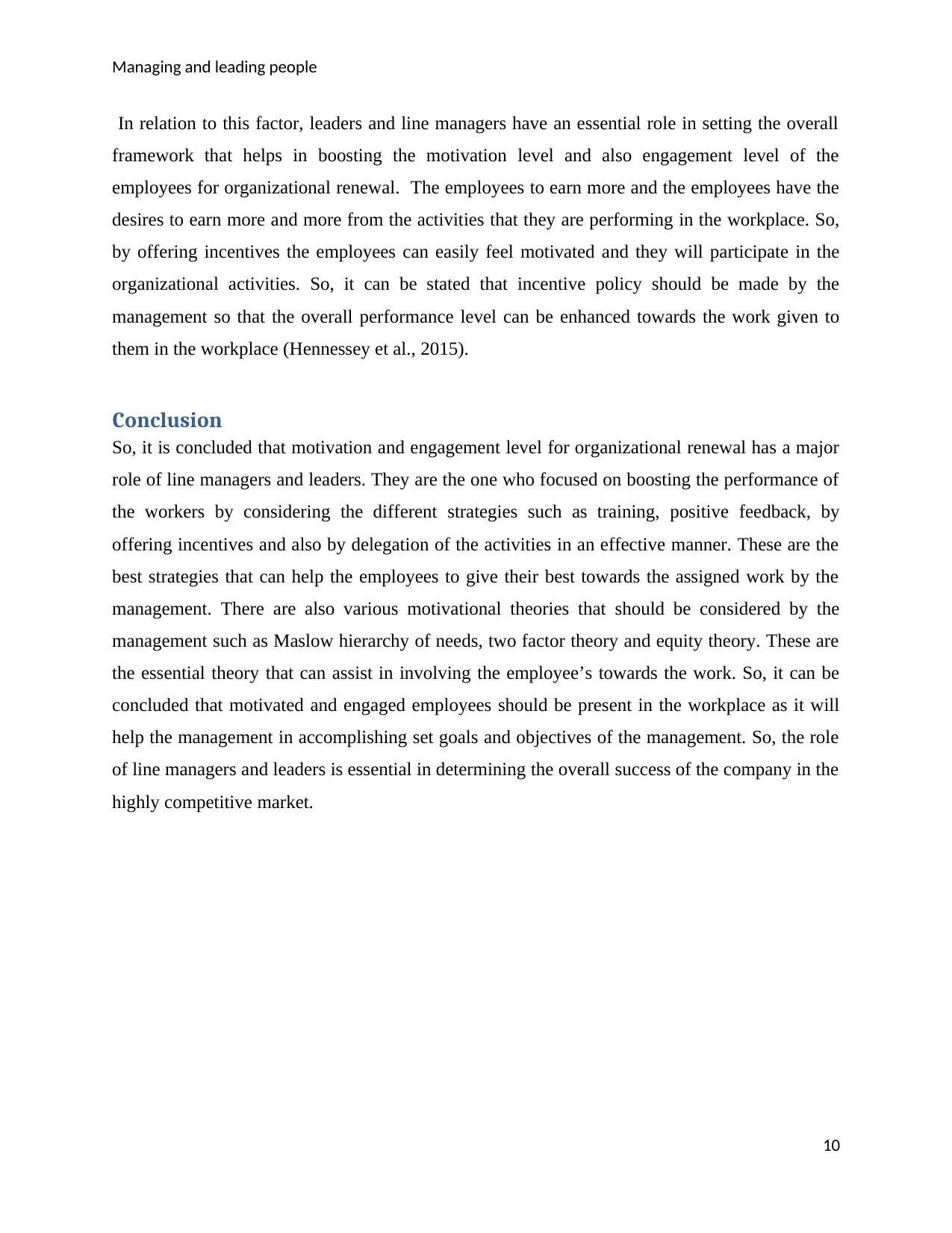
Managing and leading people
In relation to this factor, leaders and line managers have an essential role in setting the overall
framework that helps in boosting the motivation level and also engagement level of the
employees for organizational renewal. The employees to earn more and the employees have the
desires to earn more and more from the activities that they are performing in the workplace. So,
by offering incentives the employees can easily feel motivated and they will participate in the
organizational activities. So, it can be stated that incentive policy should be made by the
management so that the overall performance level can be enhanced towards the work given to
them in the workplace (Hennessey et al., 2015).
Conclusion
So, it is concluded that motivation and engagement level for organizational renewal has a major
role of line managers and leaders. They are the one who focused on boosting the performance of
the workers by considering the different strategies such as training, positive feedback, by
offering incentives and also by delegation of the activities in an effective manner. These are the
best strategies that can help the employees to give their best towards the assigned work by the
management. There are also various motivational theories that should be considered by the
management such as Maslow hierarchy of needs, two factor theory and equity theory. These are
the essential theory that can assist in involving the employee’s towards the work. So, it can be
concluded that motivated and engaged employees should be present in the workplace as it will
help the management in accomplishing set goals and objectives of the management. So, the role
of line managers and leaders is essential in determining the overall success of the company in the
highly competitive market.
10
In relation to this factor, leaders and line managers have an essential role in setting the overall
framework that helps in boosting the motivation level and also engagement level of the
employees for organizational renewal. The employees to earn more and the employees have the
desires to earn more and more from the activities that they are performing in the workplace. So,
by offering incentives the employees can easily feel motivated and they will participate in the
organizational activities. So, it can be stated that incentive policy should be made by the
management so that the overall performance level can be enhanced towards the work given to
them in the workplace (Hennessey et al., 2015).
Conclusion
So, it is concluded that motivation and engagement level for organizational renewal has a major
role of line managers and leaders. They are the one who focused on boosting the performance of
the workers by considering the different strategies such as training, positive feedback, by
offering incentives and also by delegation of the activities in an effective manner. These are the
best strategies that can help the employees to give their best towards the assigned work by the
management. There are also various motivational theories that should be considered by the
management such as Maslow hierarchy of needs, two factor theory and equity theory. These are
the essential theory that can assist in involving the employee’s towards the work. So, it can be
concluded that motivated and engaged employees should be present in the workplace as it will
help the management in accomplishing set goals and objectives of the management. So, the role
of line managers and leaders is essential in determining the overall success of the company in the
highly competitive market.
10
Paraphrase This Document
Need a fresh take? Get an instant paraphrase of this document with our AI Paraphraser
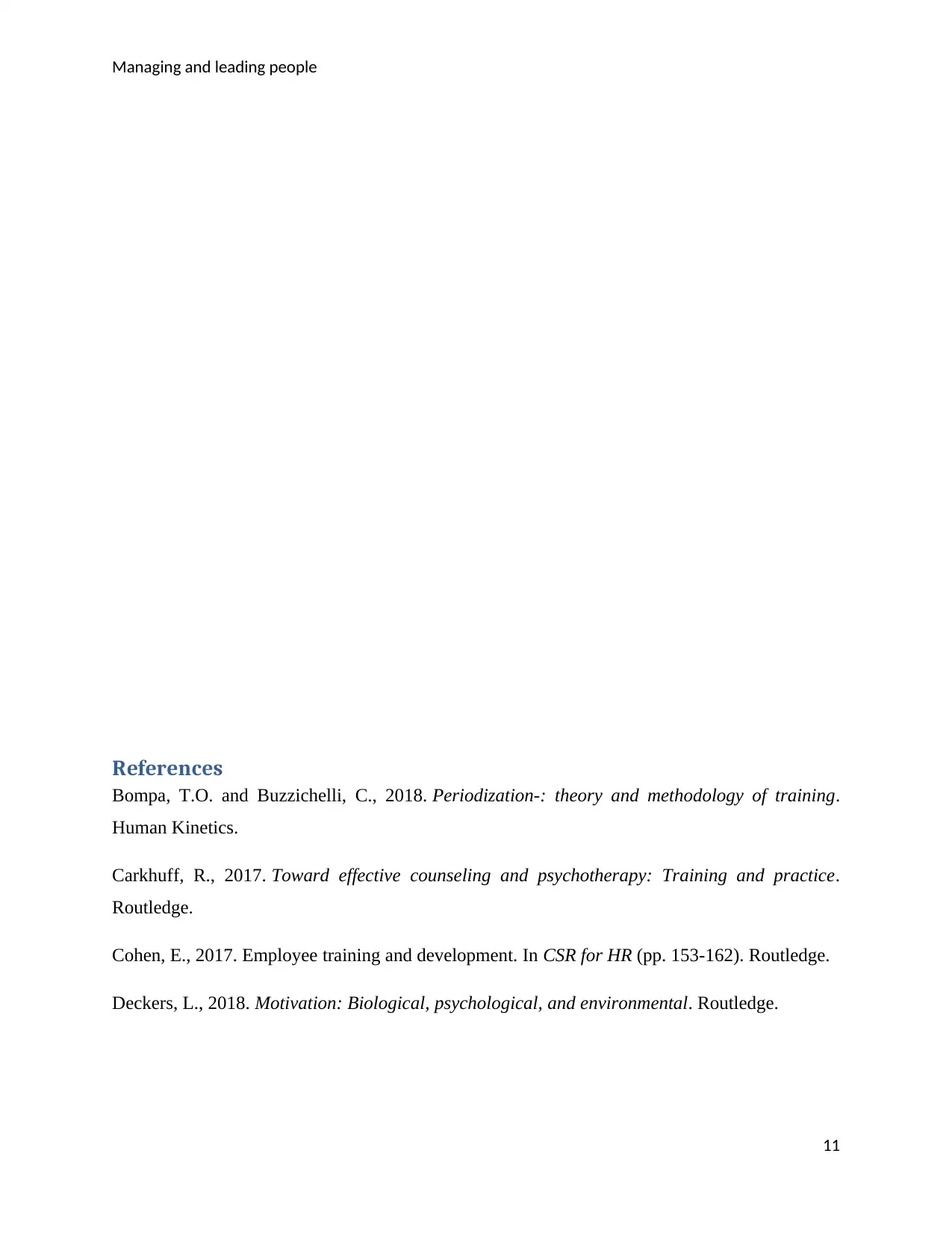
Managing and leading people
References
Bompa, T.O. and Buzzichelli, C., 2018. Periodization-: theory and methodology of training.
Human Kinetics.
Carkhuff, R., 2017. Toward effective counseling and psychotherapy: Training and practice.
Routledge.
Cohen, E., 2017. Employee training and development. In CSR for HR (pp. 153-162). Routledge.
Deckers, L., 2018. Motivation: Biological, psychological, and environmental. Routledge.
11
References
Bompa, T.O. and Buzzichelli, C., 2018. Periodization-: theory and methodology of training.
Human Kinetics.
Carkhuff, R., 2017. Toward effective counseling and psychotherapy: Training and practice.
Routledge.
Cohen, E., 2017. Employee training and development. In CSR for HR (pp. 153-162). Routledge.
Deckers, L., 2018. Motivation: Biological, psychological, and environmental. Routledge.
11
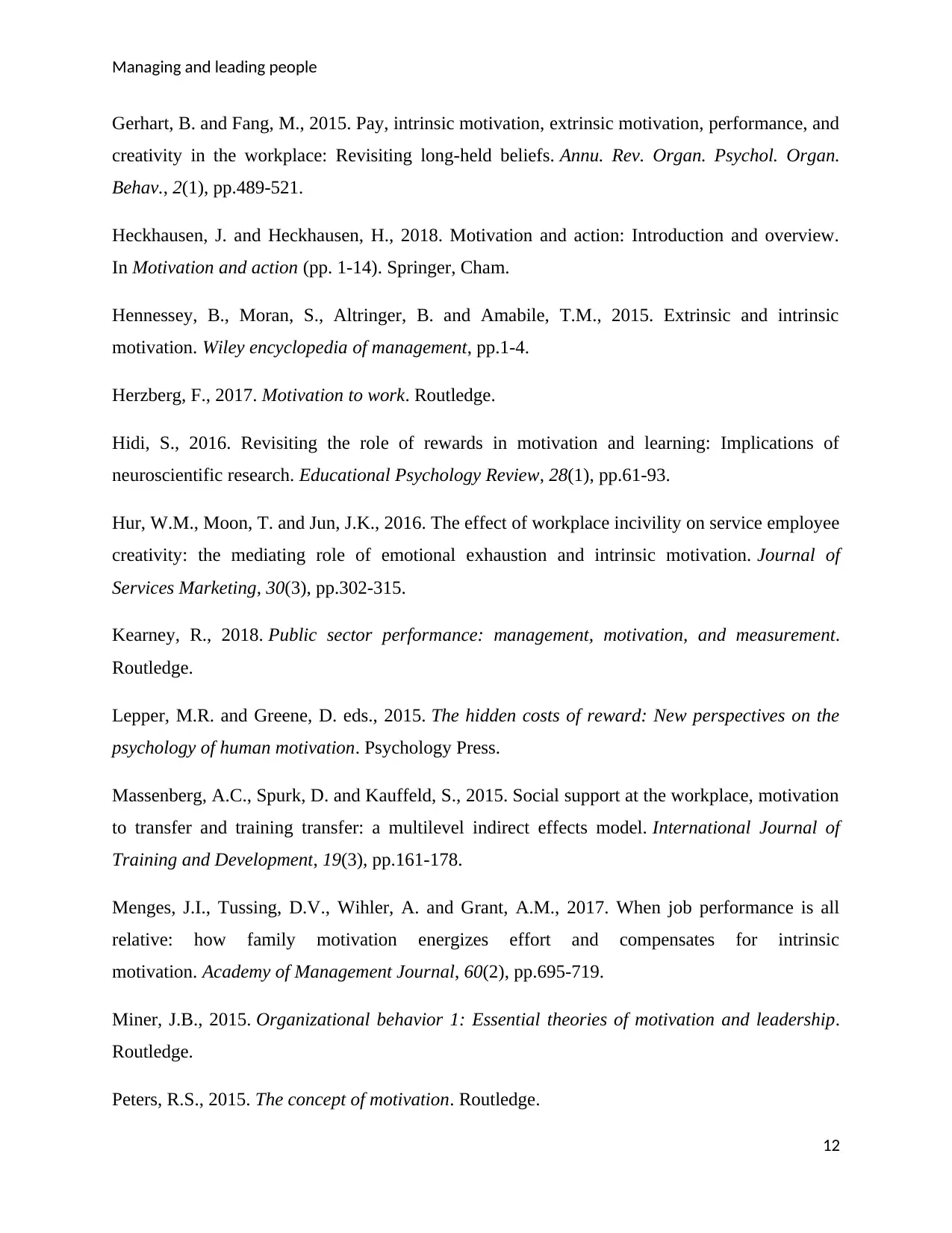
Managing and leading people
Gerhart, B. and Fang, M., 2015. Pay, intrinsic motivation, extrinsic motivation, performance, and
creativity in the workplace: Revisiting long-held beliefs. Annu. Rev. Organ. Psychol. Organ.
Behav., 2(1), pp.489-521.
Heckhausen, J. and Heckhausen, H., 2018. Motivation and action: Introduction and overview.
In Motivation and action (pp. 1-14). Springer, Cham.
Hennessey, B., Moran, S., Altringer, B. and Amabile, T.M., 2015. Extrinsic and intrinsic
motivation. Wiley encyclopedia of management, pp.1-4.
Herzberg, F., 2017. Motivation to work. Routledge.
Hidi, S., 2016. Revisiting the role of rewards in motivation and learning: Implications of
neuroscientific research. Educational Psychology Review, 28(1), pp.61-93.
Hur, W.M., Moon, T. and Jun, J.K., 2016. The effect of workplace incivility on service employee
creativity: the mediating role of emotional exhaustion and intrinsic motivation. Journal of
Services Marketing, 30(3), pp.302-315.
Kearney, R., 2018. Public sector performance: management, motivation, and measurement.
Routledge.
Lepper, M.R. and Greene, D. eds., 2015. The hidden costs of reward: New perspectives on the
psychology of human motivation. Psychology Press.
Massenberg, A.C., Spurk, D. and Kauffeld, S., 2015. Social support at the workplace, motivation
to transfer and training transfer: a multilevel indirect effects model. International Journal of
Training and Development, 19(3), pp.161-178.
Menges, J.I., Tussing, D.V., Wihler, A. and Grant, A.M., 2017. When job performance is all
relative: how family motivation energizes effort and compensates for intrinsic
motivation. Academy of Management Journal, 60(2), pp.695-719.
Miner, J.B., 2015. Organizational behavior 1: Essential theories of motivation and leadership.
Routledge.
Peters, R.S., 2015. The concept of motivation. Routledge.
12
Gerhart, B. and Fang, M., 2015. Pay, intrinsic motivation, extrinsic motivation, performance, and
creativity in the workplace: Revisiting long-held beliefs. Annu. Rev. Organ. Psychol. Organ.
Behav., 2(1), pp.489-521.
Heckhausen, J. and Heckhausen, H., 2018. Motivation and action: Introduction and overview.
In Motivation and action (pp. 1-14). Springer, Cham.
Hennessey, B., Moran, S., Altringer, B. and Amabile, T.M., 2015. Extrinsic and intrinsic
motivation. Wiley encyclopedia of management, pp.1-4.
Herzberg, F., 2017. Motivation to work. Routledge.
Hidi, S., 2016. Revisiting the role of rewards in motivation and learning: Implications of
neuroscientific research. Educational Psychology Review, 28(1), pp.61-93.
Hur, W.M., Moon, T. and Jun, J.K., 2016. The effect of workplace incivility on service employee
creativity: the mediating role of emotional exhaustion and intrinsic motivation. Journal of
Services Marketing, 30(3), pp.302-315.
Kearney, R., 2018. Public sector performance: management, motivation, and measurement.
Routledge.
Lepper, M.R. and Greene, D. eds., 2015. The hidden costs of reward: New perspectives on the
psychology of human motivation. Psychology Press.
Massenberg, A.C., Spurk, D. and Kauffeld, S., 2015. Social support at the workplace, motivation
to transfer and training transfer: a multilevel indirect effects model. International Journal of
Training and Development, 19(3), pp.161-178.
Menges, J.I., Tussing, D.V., Wihler, A. and Grant, A.M., 2017. When job performance is all
relative: how family motivation energizes effort and compensates for intrinsic
motivation. Academy of Management Journal, 60(2), pp.695-719.
Miner, J.B., 2015. Organizational behavior 1: Essential theories of motivation and leadership.
Routledge.
Peters, R.S., 2015. The concept of motivation. Routledge.
12
⊘ This is a preview!⊘
Do you want full access?
Subscribe today to unlock all pages.

Trusted by 1+ million students worldwide
1 out of 13
Related Documents
Your All-in-One AI-Powered Toolkit for Academic Success.
+13062052269
info@desklib.com
Available 24*7 on WhatsApp / Email
![[object Object]](/_next/static/media/star-bottom.7253800d.svg)
Unlock your academic potential
Copyright © 2020–2025 A2Z Services. All Rights Reserved. Developed and managed by ZUCOL.





